 W
WAcmaeodera flavomarginata is a species of metallic wood-boring beetle in the family Buprestidae. It is found in Central America, North America, and South America.
 W
WAgrilus cuprescens, known generally as the rose stem girdler or bronze cane borer, is a species of metallic wood-boring beetle in the family Buprestidae. It is found in Europe & Northern Asia and North America.
 W
WAllocerus dilaticorne is a species of beetle in the family Cerambycidae. It was described by Gory in 1832.
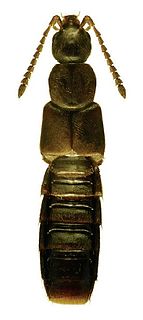 W
WAloconota sulcifrons is a species of rove beetles native to Europe.
 W
WAnthia burchelli is a species of ground beetle in the subfamily Anthiinae. It was described by Hope in 1832.
 W
WAnthia cinctipennis is a species of ground beetle in the subfamily Anthiinae. It was described by Lequien in 1832.
 W
WAnthia omoplata is a species of ground beetle in the subfamily Anthiinae. It was described by Lequien in 1832.
 W
WCarabus linnei is a species of beetle. It is endemic to Europe, where it is found in Poland, Slovakia, Hungary, and Ukraine.
 W
WCatoxantha opulenta is a species of jewel beetles belonging to the family Buprestidae, subfamily Chrysochroinae.
 W
WCheloderus childreni is a species of beetle belonging to the family Oxypeltidae.
 W
WCompsa albopicta is a species of beetle in the family Cerambycidae. It was described by Perty in 1832.
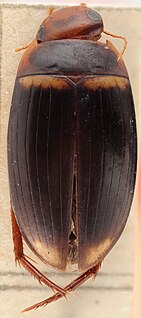 W
WCopelatus is a large genus of small diving beetles. There are some 470 described species in the genus, found worldwide, but they are most diverse in tropical South America, Africa and South-East Asia.
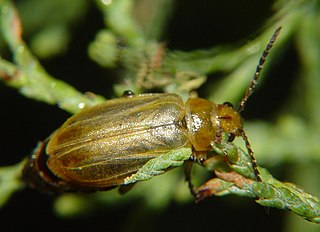 W
WDiorhabda elongata is a species of leaf beetle known as the Mediterranean tamarisk beetle (MTB) which feeds on tamarisk trees from Portugal and Algeria east to southern Russia. The MTB is used in North America as a biological pest control agent against saltcedar or tamarisk, an invasive species in arid and semi-arid ecosystems.
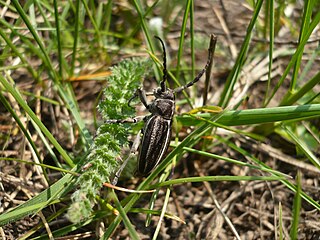 W
WDorcadion holosericeum is a species of beetle in the family Cerambycidae. It was described by Krynicky in 1832. It is known from Poland, Russia, Belarus, Moldova, Romania, Slovakia, Georgia, and Ukraine.
 W
WThe foreign grain beetle is a species of beetle in the family Silvanidae. It is related to the sawtoothed grain beetle.
 W
WGlenea versuta is a species of beetle in the family Cerambycidae. It was described by Newman in 1832. It is known from the Philippines.
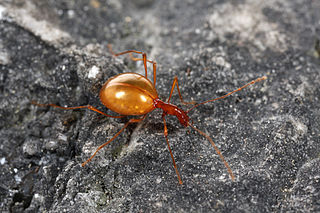 W
WLeptodirus is a cave beetle in the family Leiodidae. The genus contains only the single species Leptodirus hochenwartii. It is a true troglobite, endemic to Slovenian, Croatian and, partly, Italian caves.
 W
WLyctus carbonarius is a wood-boring beetle in the family Bostrichidae, commonly known as the southern lyctus beetle or lyctid powderpost beetle. It is a serious pest of hardwoods including ash, hickory, oak, maple and mahogany and can infest many products in the home including hardwood flooring and structural timbers, plywood, furniture, tool handles, picture frames, baskets and ladders. Timber can be infested in one location and then be transported large distances by ship, after which the beetles can emerge and spread the infestation to new areas.
 W
WNebria caucasica is a species of ground beetle from the Nebriinae subfamily that is endemic to Caucasus.
 W
WOpatroides punctulatus is a species of darkling beetle in the family Tenebrionidae.
 W
WPelidnota kirbyi is a species of beetles of the family Scarabaeidae.
 W
WPhilonthus cognatus is a rove beetle. Adults are 8 to 10 mm long. They are mainly black in colour, although the elytra have a metallic sheen, and are profusely pitted. A distinctive feature of this species is that the underside of the first antennal segment is yellow, contrasting with the black upperside. It is a common species in Britain.
 W
WPhryneta aurocincta is a species of beetle in the family Cerambycidae. It was described by Félix Édouard Guérin-Méneville in 1832, originally under the genus Lamia. It has a wide distribution throughout Africa.
 W
WStenygra conspicua is a species of beetle in the family Cerambycidae. It was described by Perty in 1832.
 W
WThermonectus marmoratus is a relatively colorful North American species of diving beetle known by the common names sunburst diving beetle and spotted diving beetle. The behavior of this diving beetle has been compared to a scuba diver, since it carries with it a bubble of air as it dives down into the water. The beetle has recently become notable when it was discovered that its aquatic larval stage is the first ever recorded use of bifocal technology in the animal world. The beetle uses in its principal eyes two retinas and two distinct focal planes that are substantially separated, in the manner of bifocals to switch their vision from up-close to distance, for easy and efficient capture of their prey.
 W
WTrictenotoma childreni, the log-boring beetle or brown steampunk beetle, is a species of beetle in the Trictenotomidae family. It can reach a body length of about 55–65 mm (2.2–2.6 in). Basic color of these large beetles is black, the body is slightly flattened, and it is covered with thick grayish-yellow hair. It has large eyes, long antennae and legs, and powerful mandibles. This species can be found in Malaysia, Myanmar, Borneo, Thailand, Indonesia, Vietnam, China, and India in damp and seasonal forests.
 W
WXylodromus brunnipennis is a species of rove beetles native to Europe.